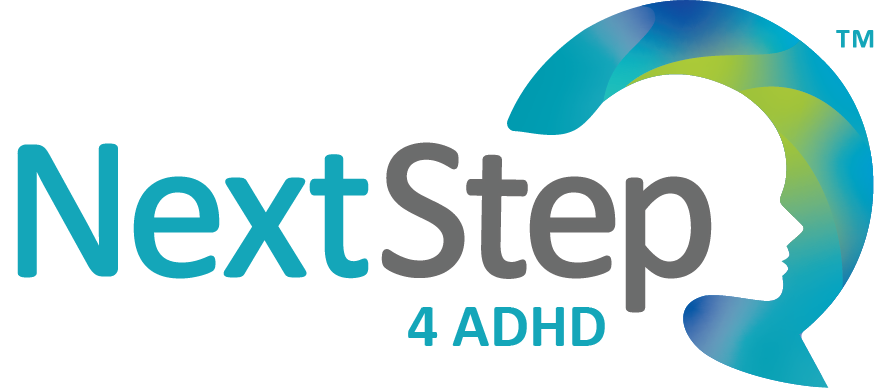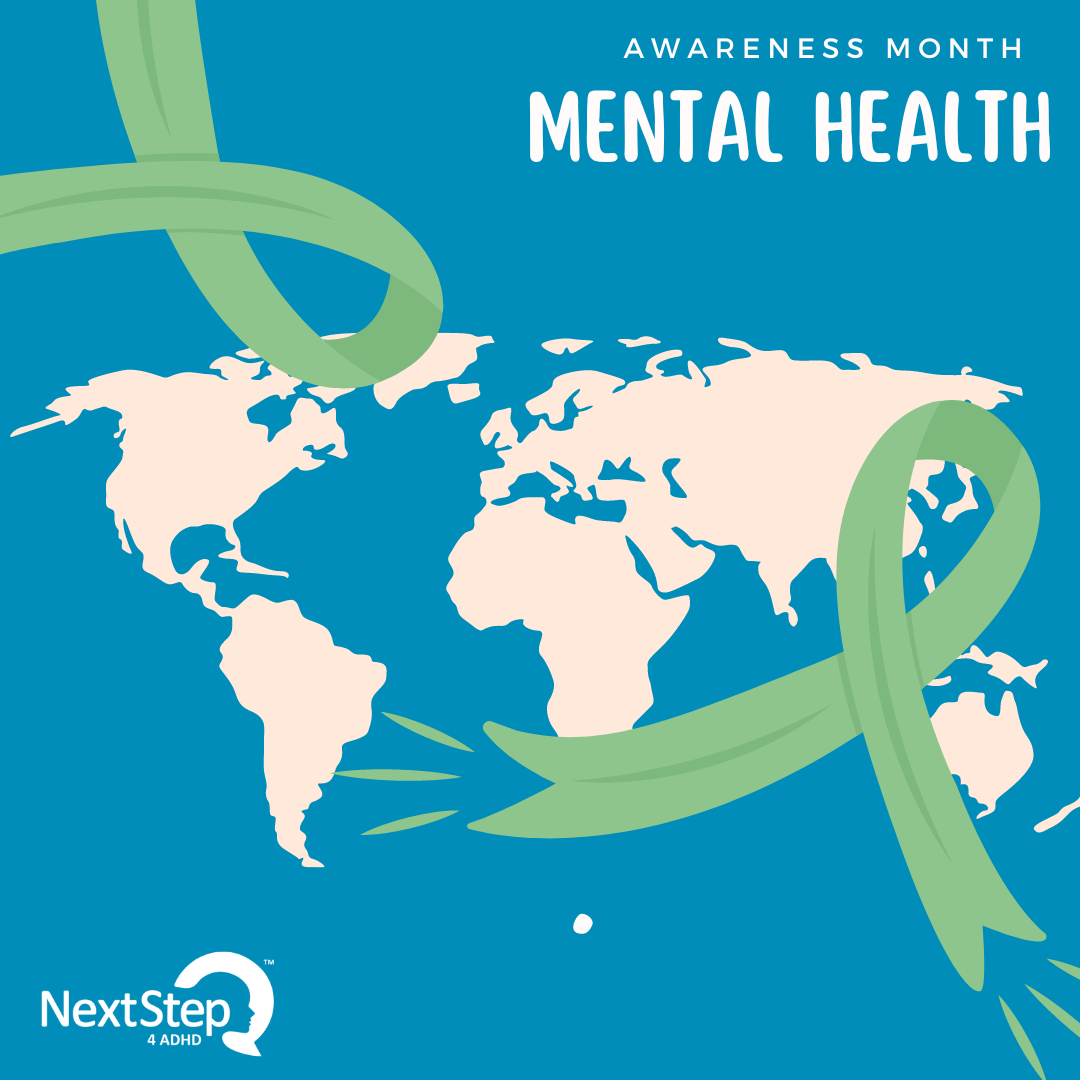
10 Essential Ways to Prioritize Your Mental Health: A Guide for Mental Health Awareness Month
May is Mental Health Awareness Month — a time dedicated to raising awareness about mental health and well-being. With busy schedules and fast-paced lives, it’s easy to overlook your mental health amidst the chaos of daily life. However, taking care of your mental well-being is just as important as caring for your physical health.
In honor of Mental Health Awareness Month, here are ten essential ways to prioritize your mental health and foster a greater sense of well-being.
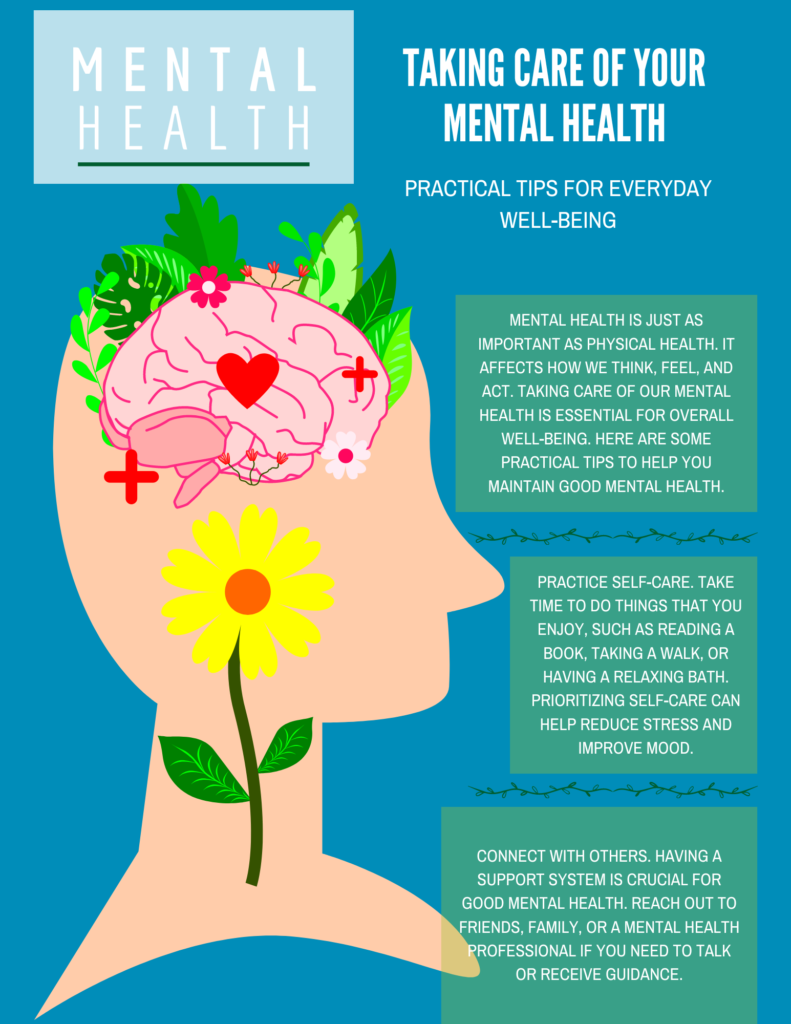
Practice Self-Compassion
Be kind to yourself. We often hold ourselves to high standards and criticize ourselves harshly for perceived shortcomings. Instead, practice self-compassion by treating yourself with the same kindness and understanding that you would offer to a friend facing similar challenges.
Prioritize Self-Care
Self-care is not selfish; it’s necessary for maintaining good mental health. Make time for activities that bring you joy and relaxation, whether it’s reading a book, taking a walk in nature, practicing mindfulness, or indulging in a hobby you love.
Establish Healthy Boundaries
Learn to set boundaries in your personal and professional life to protect your mental and emotional well-being. Saying no when you need to, and prioritizing your needs helps prevent burnout and resentment.
Stay Connected
Human connection is vital for our mental health. Nurture your relationships with friends and family members, and don’t hesitate to reach out for support when you need it. Social support can provide comfort, encouragement, and a sense of belonging.
Practice Mindfulness and Meditation
Mindfulness and meditation are powerful tools for managing stress, reducing anxiety, and promoting emotional balance. Take a few minutes each day to practice mindfulness or meditation, focusing on your breath or simply observing your thoughts without judgment.
Get Moving
Regular exercise has numerous benefits for both physical and mental health. Whether it’s going for a run, practicing yoga, participating in organized sports, or taking a dance class, find a form of exercise that you enjoy and make it a regular part of your routine.
Seek Professional Help
If you’re struggling with your mental health, don’t hesitate to seek professional help. Therapy can provide valuable support, guidance, and coping strategies for managing mental health challenges. There is no shame in asking for help when you need it.
Limit Screen Time
Excessive screen time, especially on social media, can have a negative impact on our mental health, contributing to feelings of inadequacy, anxiety, and loneliness. Set boundaries around your screen time and prioritize real-life connections and activities.
Tip: you can also set time limits on devices for your children through parental control settings.
Practice Gratitude
Cultivate an attitude of gratitude by regularly reflecting on the things you’re thankful for in your life. Keeping a gratitude journal or simply taking a moment each day to appreciate the small blessings can shift your perspective and improve your mood.
Get Plenty of Sleep
Quality sleep is essential for good mental health. Prioritize getting enough restful sleep each night by establishing a bedtime routine, creating a comfortable sleep environment, and avoiding caffeine and screens before bed.
Prioritize Your Mental Health This May
Your mental health is a precious asset that deserves your care and attention. By incorporating these ten strategies into your daily life, you can prioritize your mental well-being and cultivate resilience in the face of life’s challenges. Remember, seeking help is a sign of strength, not weakness, and you are worthy of support and compassion. This Mental Health Awareness Month, commit to taking proactive steps to care for your mental health and inspire others to do the same.
Click here to request an appointment with our multidisciplinary team.
Learn More
Quiz: Are You a Meal Prepper? Discover the ADHD Benefits
Meal prepping can be a game-changer, especially for those with ADHD. It’s not just about organizing your meals; it’s about improving focus, managing impulsivity, and setting yourself up for success.
Take this quiz to find out if you’re a meal prepper and learn about the incredible benefits it offers for individuals with ADHD.
Quiz Time: Are You a Meal Prepper?
1. Do you plan your meals in advance, at least a few days ahead?
- Always
- Sometimes
- Rarely
- Never
2. How often do you cook multiple servings of a dish to eat throughout the week?
- Every week
- Once in a while
- Rarely
- Never
3. How do you feel about grocery shopping?
- Excited, I love it!
- Neutral, it’s okay.
- Overwhelmed, but I manage.
- It’s a struggle.
4. What’s your reaction when you’re hungry but don’t have a meal ready?
- No worries, I have a stash of prepped meals.
- I’ll figure something out quickly.
- I might grab unhealthy snacks.
- Panic mode – it’s chaos!
5. How much time do you spend on meal preparation each week?
- About an hour a day
- A few hours on the weekend
- Whenever I find time
- I play it by ear
Results:
If you answered mostly:
- A’s: Congratulations, you’re a meal prepper pro! You understand the value of planning ahead and have likely experienced the benefits it brings.
- B’s: You’re on the right track! You might not meal prep consistently, but you’re aware of its advantages.
- C’s: Meal prepping isn’t your strong suit, but you’re open to exploring its potential benefits.
- D’s: Meal prepping could be a game-changer for you. Consider the positive impact it could have on managing ADHD symptoms.
The ADHD Benefits of Meal Prepping
1. Improved Focus:
Meal prepping reduces decision fatigue by eliminating the need to figure out what to eat each time you’re hungry. This helps conserve mental energy, allowing you to stay focused on important tasks.
2. Reduced Impulsivity:
Having prepped meals on hand helps prevent impulsive food choices, which can be common for individuals with ADHD. You’re less likely to grab unhealthy snacks or opt for fast food when you already have nutritious meals ready to go.
3. Time and Energy Savings:
Meal prepping might seem time-consuming upfront, but it saves time and effort throughout the week. You’ll spend less time cooking on a daily basis, giving you more room for other activities.
4. Consistent Nutrition:
People with ADHD often struggle with maintaining consistent eating patterns. Meal prepping ensures that you have balanced meals available, which can positively impact your overall well-being.
5. Stress Reduction:
The peace of mind that comes with knowing you have meals ready can significantly reduce stress. You won’t have to worry about last-minute food arrangements.
Recap
Meal prepping isn’t just for fitness enthusiasts; it’s a powerful tool for staying organized and ensuring you maintain a balanced diet. By taking the quiz and considering the benefits, you’ve taken the first step toward incorporating this strategy into your routine. Give meal prepping a try and experience the positive impact it can have on your focus, impulsivity, and daily productivity. Your journey to better ADHD management starts in the kitchen!
Need Help Managing ADHD?
Do you need help with time management or other organizational strategies? Whether you need ADHD coaching or therapy, our multidisciplinary team has everything you need under one roof. To get started, request an appointment today.
Learn More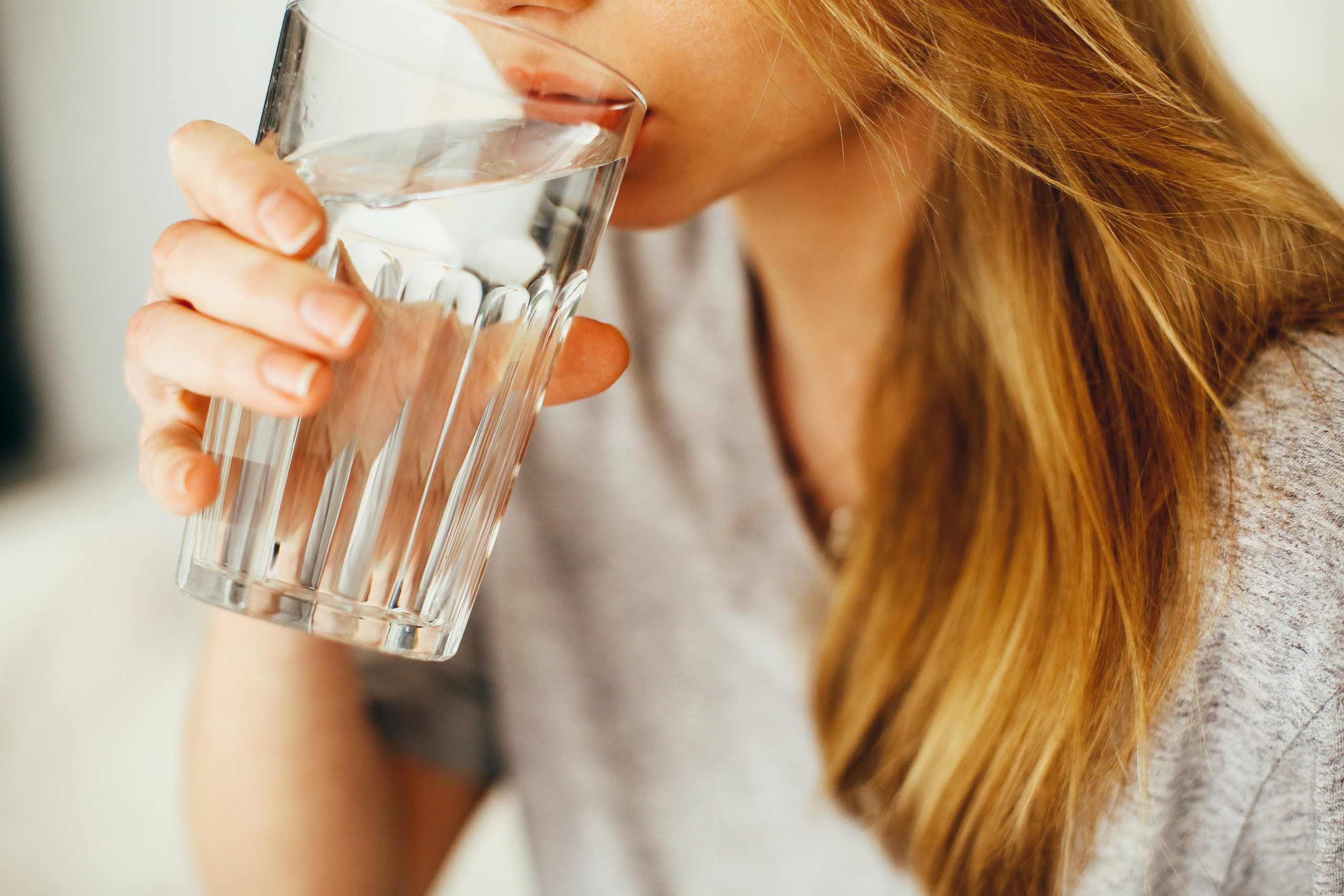
7 Ways to Stay Hydrated (and How Hydration Impacts ADHD)
Managing your ADHD symptoms matters, and controlling those symptoms plays a big role in your quality of life. There are many strategies to choose from when it comes to ADHD. For example, if you struggle with time management, you might include some planning and organizing strategies in your daily routine.
But what about brain fog? Brain fog is a common ADHD symptom, and according to the experts at Harvard Health, brain fog (and task initiation and forgetfulness) can all be linked to ADHD.
Brain fog can also develop due to lack of sleep, not drinking enough water, and not eating enough protein, so it’s important to focus on self-care too.
Is lack of water exacerbating your brain fog symptoms? In this article, we’ll highlight seven strategies for staying hydrated.
7 Strategies for Staying Hydrated
Need help staying hydrated? Experts suggest that adults drink eight 8-ounce glasses of water each day, although this number can vary. You might need more fluid intake if you’ve been working out, live in a hot, dry climate, or if you’ve lost a lot of water through sweating.
You can support hydrating with these strategies:
- Add fresh fruit slices to the water for a fun treat! Lemon, strawberries, oranges, pineapple, and limes are particularly refreshing.
- Tip: slice each fruit very thin. The thinner the fruit, the more infused the water becomes.
- Add fresh herbs such as mint. (You can also combine fresh herbs with fresh fruit.)
- Keep a bottle with you at all times. It’s much easier to stay hydrated when your water bottle is already at your desk.
- Find a large water bottle. The larger it is, the less likely you’ll have to go refill it, making it more likely that you’ll log those ounces!
- Drink one glass of water as soon as you wake up — so you can start the day off right!
- If you exercise, be sure to bring water with you to the gym (or just keep it next to you if you work out at home.)
- Keep a pitcher of fresh water on your dinner table.
You can also log your glasses in an app or on a note-pad if it helps you keep track. The goal is to stay hydrated and build healthy habits that support your mind and body.
How Water Improves Your Mental Health
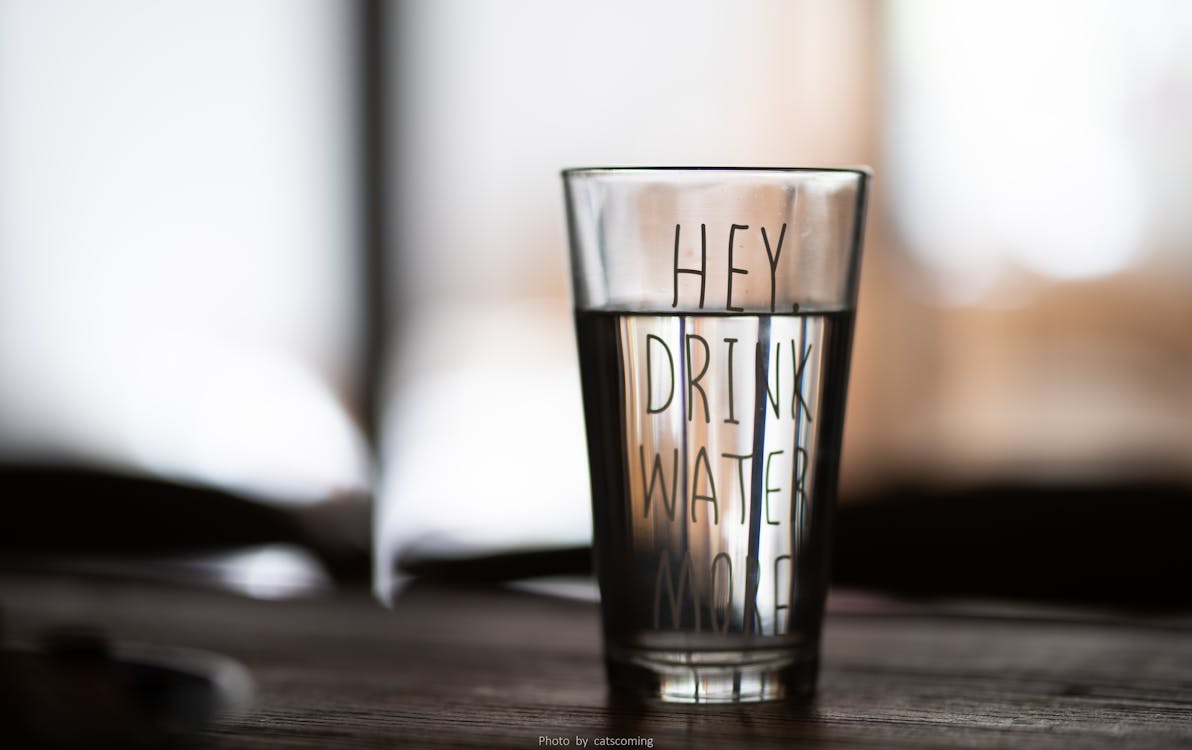
Drinking 64 ounces of water isn’t a magical cure. It won’t eliminate or cure ADHD, but staying hydrated does support your brain health and improve brain functioning, according to a 2018 study published in the World Journal of Psychiatry.
“Water facilitates signaling pathway and nutrients delivery to the brain, removes toxins and inflammatory markers and provides energy sources for brain, and thereby improves brain function.
The World Journal of Psychiatry
Researchers from the same study found that individuals who chronically didn’t drink enough water had higher levels of anxiety.
Other Self-Care Strategies
Self-care isn’t just a mani-pedi or a trip to the spa. Self-care is about taking care of your entire mind and body. Examples of self-care includes:
- Eating well-balanced and nutrient-dense meals
- Staying hydrated
- Sleeping 7-9 hours each night
- Exercising daily
- Making appointments (healthcare, mental health care, dental, etc.)
- Spending time each day doing something you love (reading, crocheting, etc.)
To learn more about self-care, you can take our free Self-Care for ADHD course.
If you need help managing ADHD, our compassionate and expert team excels in diagnosing ADHD. We also offer therapy, ADHD coaching, and medication management.
Call our Louisville, Kentucky office at 502-907-5908. You can also book an appointment here.
Learn More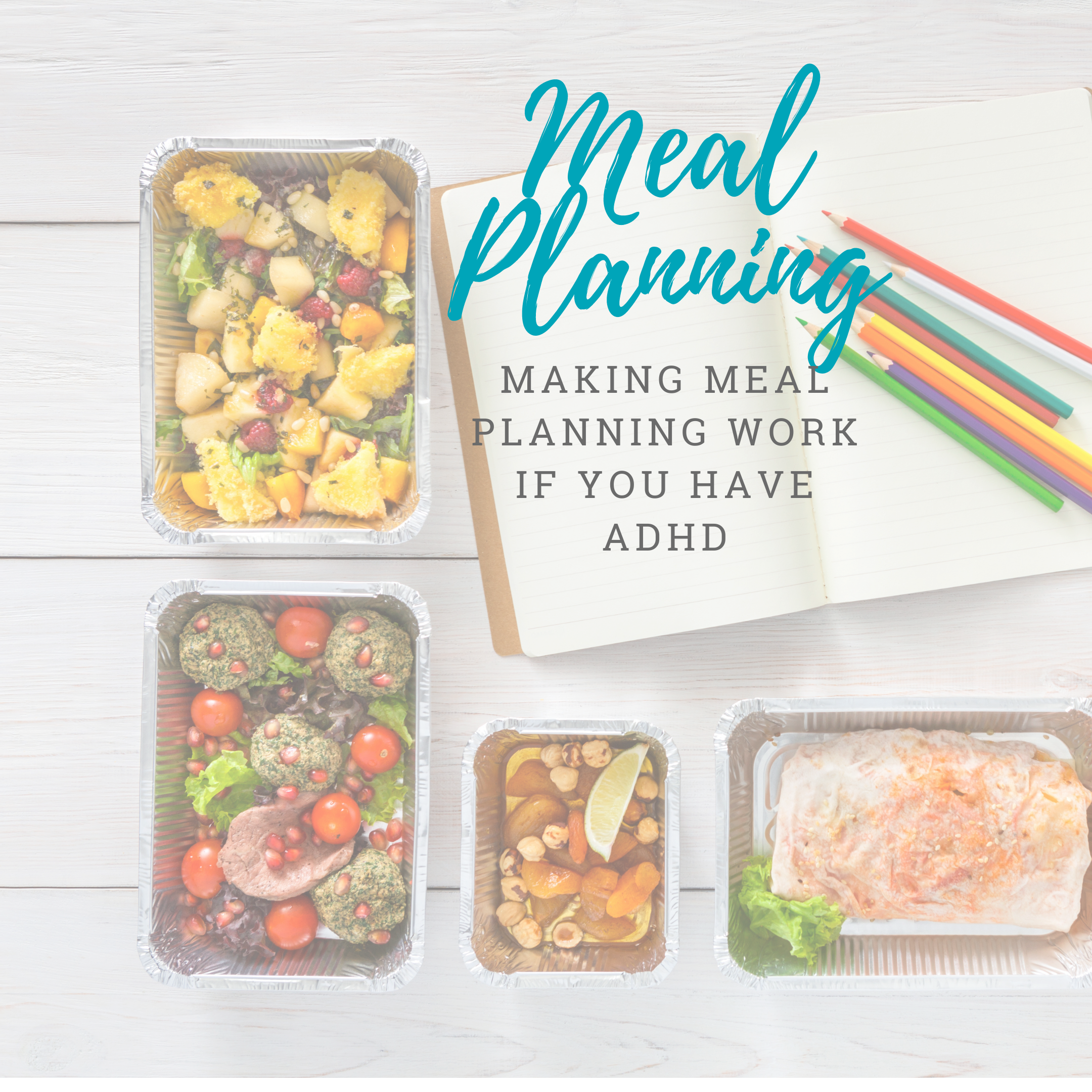
Meal Planning & ADHD: 9 Tips to Make It Work
Planning meals for your family can be stressful — especially if ADHD leads to feeling disorganized and unprepared. Learning how to meal planning can eliminate some stress around mealtimes.
Why Is Meal Planning Hard If You Have ADHD?
Meal planning refers to taking the time to choose your meals for the week. It can also include making your grocery list for the week too. So why is this so difficult if you have ADHD? Meal planning requires decision-making, planning, prioritizing — all of which are executive function skills. Because ADHD can lead to struggles with executive function skills, the struggle makes sense.
In other words, meal planning can be overwhelming and incredibly ADHD-unfriendly. The good news is that meal planning is a skill – and skills can be learned. In this article, we’ll explore the benefits of meal planning as well as 10 tips to make meal planning less overwhelming.
5 Benefits of Meal Planning for Your Family
Meal planning provides many benefits for you and your family. Exploring these benefits can be really motivating to stick with your plan. Think of this as your WHY as you embark on meal planning.
Meal planning can provide the following five benefits:
- Reduces the feelings of overwhelm around planning for meals.
- Helps you eat healthier. Planning ahead gives you a better chance of planning healthier meals.
- Saves you time. Save time by avoiding the need to run to the store multiple times. You’ll also save time each night because you won’t have to think about what to make — you already know.
- Saves you money. You can save money by reducing cutting out impulse buys and by avoiding duplicate purchases. Planning ahead also gives you an opportunity to take advantage of the weekly sales at your grocery store. Planning ahead also helps you stick with your budget.
- Helps you cut back on fast food. We’ve all been there: it’s late and dinner isn’t made yet — so you order take-out. Planning ahead cuts out last minute fast-food choices.
In the next section, we’ll share tips for making meal planning less overwhelming.
9 Strategies for Making Meal Planning Easier
1. Make a Master List of 10 Recipes
A master list of recipes provides quick and easy references to some of your family’s favorite recipes.
Tips for making a master list:
- Include plenty of easy recipes for busy nights (think: Instapot or CrockPot recipes)
- Sort your recipes by category (beef-based, pasta dishes, chicken, side dishes, soups, etc)
- Keep them written down (in a blank journal, on a Word document, or on flashcards in a recipe box organizer)
When meal planning, you can refer to your master list to fill out your weekly meals. You can use as many recipes as you want. You might use meals only from your master list. Or, you can use some from your list and try 1-2 new recipes each week. Do what works for you.
Need inspiration? You get your free ADHD-friendly recipe book here.
2. Don’t Try to Memorize Your Meal Plan
 Trying to memorize your meal plan will increase the risk that you deviate from the plan. You can write your meal plan:
Trying to memorize your meal plan will increase the risk that you deviate from the plan. You can write your meal plan:
- In a daily paper planner
- In an app
- On a dry erase board hanging in your kitchen
Tip: Using the dry erase board in the kitchen might be helpful to make sure your whole family is on the same page. This can limit the “What’s for dinner?” question.
3. Plan All of Your Meals
If you don’t make a plan for breakfast or lunch, you’ll more likely to either skip the meal or grab something quick from a drive-thru.
Include all of your meals when you meal plan. This doesn’t mean that breakfast or lunch has to be elaborate, time-consuming meals, either.
Examples include:
- Hard-boiled eggs and toast and a piece of fruit
- Overnight oats
- Brown bag lunch ideas such as leftover meat from dinner as a sandwich
Even if breakfast and lunch are quick meals, planning for them gives you time to get them ready. For example, if you know you want hard-boiled eggs for breakfast, you can make sure you allot time in the morning to get that done.
4. Check Your Daily Schedule
What if you have to work late on Tuesday? What if the kids have a dance recital on Thursday? Even on the busiest nights, you’ll still need dinner — but by taking your calendar into consideration, you ensure that you’ll have dinner ready.
Tip: You might designate busy nights as the slow-cooker night. You can also designate busy nights as leftover night — just reheat and go!
5. Check Your Pantry
When you’re meal planning, you don’t need to make 7 dinners each night from scratch with a pantry overhaul. You can use what you already have in your pantry to inspire your meals for the week.
For example, if you have a lot of canned tomatoes in your pantry, then plan a spaghetti night. Lots of chicken in your freezer? Try a pulled chicken recipe in your crockpot.
6. Choose In-Season Produce
Plan meals based on what’s in season. For example, planning a berry-based salad in the middle of winter might not lead to the best salad. Out-of-season produce tends to have less flavor and be more expensive.
Tip: If you want a fruit that is out-of-season, try the frozen version.
7. Don’t Forget to Plan for Leftovers
One of the most frustrating things is to end the week with a fridge full of leftovers. Instead, plan for your leftovers. Leftover night can be quite handy on busy nights.
Leftover nights cut down on wasted food, and it also gives you a night off of cooking.
How to make leftover nights not-so-boring:
- Get creative! If you don’t like having the same meal twice, you can repurpose your meals. For example, if you had steak on Monday, use the leftover steak to make steak tacos on Wednesday.
- Leftovers aren’t just for dinner. Make your lunches out of dinner leftovers. For example, if you have leftover roast chicken, you can slice it and top your salad with it.
8. Make Extra and Freeze It
Time-permitting, make a double batch of your favorite recipes. You can eat one batch for dinner, and then freeze the second batch for later. This can come in handy the following week if you need a quick dinner.
What can you freeze? Consider making double batches of meals such as:
- Soups (Lay flat in a Ziploc to freeze; once frozen, you can turn upright and stack soup easier.)
- Chili
- Bolognese sauce
- Waffles
- Meatloaf or salmon loaf
9. Schedule Your Meal Planning Time
The first step to meal planning is actually doing it. Set aside designated time to work on your meal plan in peace. It shouldn’t take more than 30 minutes.
Need More Guidance?
If you’re still feeling overwhelmed with planning and organizing tasks, we can help. Here at Next Step 4 ADHD, we provide comprehensive, multimodal support, including:
- Medication management
- Therapy
- ADHD coaching
- Online courses, including our FREE self-care course which focuses on nutrition
To make an appointment or to learn more, call us at 502-907-5908. You can also request an appointment here.
Learn More
Cardio or Strength Training: Which Is Better Exercise for ADHD?
It’s a given: exercise is essential for a healthy body and a healthy mind. Exercise can lift your mood, help you sleep better at night, and reduce your chances of developing certain diseases — the benefits of exercise are endless. But did you know that exercise can (sometimes dramatically) reduce the troublesome symptoms of ADHD?
In fact, exercise is one of the three main pillars of self-care. Whether you’re into jogging or Peloton biking or hiking in the mountains, exercise is an important component of a holistic ADHD treatment plan. But when it comes to exercise and ADHD, which type of exercise is better?
Let’s dive in.
Aerobic Exercise for ADHD
First, what is aerobic exercise? Aerobic exercise — which means exercise “with oxygen” — is cardiovascular conditioning. You probably call this type of exercise “cardio,” and it can include activities like dancing, walking, swimming, jogging, or biking. One of the key differences here is that your breathing and heart rate will increase during these activities.
Is cardio good for managing ADHD symptoms?
Dr. John Ratey, a neuropsychiatrist from Harvard Medical School, says YES!
In an article published by the Attention Deficit Disorder Association, Dr. Ratey explains, “The best types of exercise encourage the development of connections between parts of the brain and in addition, stimulate the brain to release neurotransmitters (brain chemicals that improve the symptoms of ADHD).”
Finding the Right Cardio
The ideal activity to help manage the symptoms of ADHD:
- Is aerobic
- Requires you to remain alert
- Requires you to make quick changes (such as tracking the racquetball and pivoting quickly to return the ball)
- Involves cooperation and interaction with others
- Is connected to a personal meaning for you
- Is fun
You may find that many activities fit these requirements. A few examples include dancing, Zumba classes, soccer, tennis and racquetball, running (especially with a running group), walking, HIIT and Tabata, and jump rope. Martial arts — including ju jit su, karate, and tae kwon do — are also a good aerobic exercise for individuals diagnosed with ADHD. These sports have been shown to increase focus during homework, enhance academic performance, and decrease misbehavior in children diagnosed with ADHD. [1]
Dance is another activity that hits the above-mentioned requirements. It’s aerobic, it’s fun, it requires quick changes, and if you involve your family, it can give you the opportunity to develop a personal meaning with the activity. And the best part? You don’t even need to leave your home. You can find a dance-themed workout easily on YouTube. Interested? Grab your gym shoes and get groovin’!
Why Is Cardio Good for People with ADHD?
During an aerobic activity, your body requires more oxygen, which means your heart is pumping more blood to the brain. And more blood = more oxygen. More oxygen means that your brain cells are better-nourished, which can supercharge focus, the ability to learn, memory, and even emotional regulation, for 2 to 3 hours afterwards.
Specifically, scientists have linked vigorous, high-intensity workouts with more active brain cells. What does this have to do with ADHD? When the brain cells become more active, there is a surge in the production of a protein called brain-derived neurotrophic factor (BDNF). What?!
If you’ve never heard of BDNF, that’s okay! But this is the takeaway:
- Exercise encourages your brain to produce a protein called BDNF.
- BDNF is “associated with cognitive improvement and the alleviation of depression and anxiety,” according to a 2016 study published in eLife.
And here’s the important part: cardio workouts give the biggest boost to BDNF production.
Cardio helps in other ways too. Dr. Gimpel, a board-certified psychiatrist and neurologist and head of the Brain Power Clinic in Jerusalem also shares in the importance of cardio:
“Exercise alone increases levels of dopamine, which could improve concentration for hours after completion. But combine that exercise with a deep mental focus and patients may see even more positive results. I have businessmen that do not hold meetings unless they’re between 9 and 11 in the morning,” says Dr. Gimpel. “They go to the fitness center in the morning and create those perfect two hours of concentration without medication.”
So, the score:
- Cardio: 1
- Strength training: 0
Strength Training Exercise for ADHD
What is strength training? Strength training refers to exercises that build your endurance and strength. It includes lifting weights, but you’re not limited to using weights. You can use your own bodyweight to perform strength training exercised. This includes sit-ups, push-ups, pull-ups, etc.
Is strength training good for people with ADHD? YES!
Strength training can also help reduce the symptoms of several mental health conditions, including depression, anxiety, and ADHD. How? Exercise-triggered endorphins — the “happy” hormones — get a lot of credit, but strength training does more. It also provides you with an opportunity to overcome obstacles (like reaching new rep goals or smashing your push-up record) in a controlled manner. Overcoming controlled obstacles has a direct (and positive) impact on your mental resiliency, according to research from Harvard Medical School.
You don’t need to become a bodybuilder though. For the greatest effects on mental well-being, a 2014 review published in the journal Frontiers in Psychology highlights that using low to moderate weights (i.e. lighter than 70 percent of what you can lift for one rep) has the greatest effects on your mental health.
So, the score:
- Cardio: 1
- Strength training: 1
It’s a TIE! Pam Valdes explains, “The bottom line is that there is no definitive answer. The majority of research tends to lean towards cardio being more beneficial to brain function, but then again, cardio is the mode that has been studied in most of the research, so the results may be skewed.”
Combining the Benefits of Cardio and Strength Training
For optimal physical and mental health, you can benefit from both cardio and strength training. According to the American Heart Association, you should aim for:
- 150 minutes of moderate activity per week
- 2 strength training sessions per week
Regardless of which type of exercise you choose, be sure to choose activities that are social, fun, and meaningful.
Which Type of Exercise Should YOU Do?
Certified Health Coach Pam Valdes weighs in:
The absolute best exercise for ADHD is the one you will actually do. It’s perfectly fine – maybe even helpful – if that changes from year to year, or even day to day.”
If you’re stuck — or you have a hard time logging your workouts — we can help. With our ADHD coaching program, we can help you learn the strategies you need to meet your self-care, exercise, and nutrition goals.
About Pam Valdes
 Pam Valdes is a certified Health Coach with a focus on ADHD coaching. She has a strong background in wellness and counseling. She has provided compassionate coaching to adults and teens for over 10 years.
Pam Valdes is a certified Health Coach with a focus on ADHD coaching. She has a strong background in wellness and counseling. She has provided compassionate coaching to adults and teens for over 10 years.
You can reach Pam directly through our coaching line at 502-475-3296. Alternatively, you can request an appointment here.
References:
- Morand, Matthew K., et al. “The Effects of Mixed Martial Arts on Behavior of Male Children with Attention Deficit Hyperactivity Disorder.” Unpublished doctoral dissertation Hofstra University, Hampstead, NY (2004).

10 Benefits of Exercise (Plus, How to Make It Part of Your ADHD Treatment Plan)
There’s no denying that the right ADHD medication can make a big impact in your quality of life. But do you know that exercise can also help you manage your ADHD symptoms?
We talked to Next Step Health Coach Pam Valdes to understand the benefits of exercise and how/why exercise should be a part of your holistic ADHD treatment plan.
Why Exercise is Important if You Have ADHD
Exercise isn’t just good for losing weight or building lean muscle mass — although it does help with those goals. Exercise can help keep your brain in shape, too.
Here’s how exercise helps your brain work better:
Exercise releases neurotransmitters:
When exercising, the brain releases endorphins – hormone-like compounds that regulate mood, pleasure, and pain. Exercise also elevates dopamine, norepinephrine, and serotonin, which affect focus and attention – this is what stimulants do. People with ADHD often have less dopamine than usual in their brain, and dopamine helps with clear thinking and attention.
Exercise turns on the pre-frontal cortex:
Exercise also turns on the pre-frontal cortex of brain, which plays a major role in strengthening your executive function skills. Pam explains, “Neuropsychological effects of exercise are greatest with those individuals with baseline executive function deficits, as commonly seen in ADHD.
Exercise improves brain structure:
Yep, you read that correctly: exercise improves brain structure and functioning – one of the few things that can be done after age 25 to increase neurogenesis.
Physical activity is one of the most underutilized interventions to improve ADHD-related cognitive function. This doesn’t mean exercise is a replacement for medication. Pam explains, “It’s not a replacement for meds, but an important complement to it, and exercise can sometimes reduce amount of medication needed.”
10 Benefits of Exercise
Exercise can affect your physical health as well as your mental health whether you have ADHD or not. According to Pam, exercise can provide the following ten benefits:
- Improved concentration, focus, and attention
- Improved regulation of mood – it can help you feel more calm and less irritable, and even reduce the symptoms of depression
- Improved quality and quantity of sleep
- Increased productivity
- Reduced stress
- Improved working memory and clarity of thought
- Increased motivation
- Increased sense of control, less hyperactivity, more impulse control
- Improved general health
- Increased self-confidence and sense of self-efficacy – reduces learned helplessness
According to the CDC, these benefits extend to both adults and children.
How ADHD Can Impact Exercise
While exercise can reduce the severity of ADHD symptoms, the reverse is also true. Unmanaged ADHD can impact your exercise routines. In fact, Pam says, “Individuals with ADHD tend to be less physically active.” But why? Below are a few examples of how unmanaged ADHD can affect your ability to stay active:
- Struggling with motivation and impulse control can make it difficult to begin exercising
- Poor planning can create problems putting an exercise goal into action
- Overscheduling and over commitment can make it hard to make time for exercise
- Procrastination can make it easy to put off your exercise plan
- Poor organization skills can make it a challenge to make arrangements to exercise
- Problems with prioritization can make easy to put your needs last
- Feeling down or depressed can make it a challenge to take any action
Do you find yourself agreeing with the above statements? You’re not out of luck, though! With a multidisciplinary-treatment plan, coaching, therapy, and medication can help you reach your goals.
How Much Exercise Do You Need?
“Some physical activity every day is best, but that doesn’t mean you have to go to the gym everyday – ways to work small bursts exercise into your day,” Pam explains.
“A 2006 study by Arthur Kramer, Ph.D., used MRI scans to show that walking as few as three days a week for six months actually increased the volume of the prefrontal cortex in older adults,” she continues. This means that exercise can produce immediate results and can be used right before a test or important meeting to optimize brain function.
Don’t forget to follow the 5-minute rule: Even a little bit of exercise (just 5 minutes if that’s all you can find) is so much more than none!
What Kind of Exercise Is Best for ADHD?
“Any exercise is beneficial, but exercise that incorporates balance, strategy, focus, and sequencing can be especially helpful,” Pam explains.
Any of the martial arts, ballet, ice skating, gymnastics, rock climbing, mountain biking, whitewater paddling, and skateboarding are especially good for adults and children with ADHD. Why, exactly? The technical movement inherent in these types of sports activate a vast array of brain areas that control balance, timing, sequencing, evaluating consequences, switching, error correction, fine motor adjustments, inhibition, and, of course, intense focus and concentration.
That is not to say that activities such as lifting weights or going for a walk are not helpful – they are! Consider outdoor workouts for mood-enhancing benefits. Yoga and Pilates can be great for calming the mind, in addition helping with focus and concentration.
Bottom line: The best kind of exercise? The kind that you will stick with and enjoy!
Exercise As Self-Care
Exercise is a great form of self-care, and it’s something that you should incorporate into your daily schedule. You can learn more about the benefits of exercise and other forms of self-care in our free video series, “A Happier You Starts with Self-Care.”
Exercise as Self-Care
Nutrition as Self-Care
Sleep As Self-Care
Get the ADHD Treatment You Deserve
Here at Next Step, we’re proud to offer a multidisciplinary and holistic approach to you and your child’s mental health needs. Whether you’ve been diagnosed for years, or you’re just now starting your treatment journey, we can guide you with your next steps so you and your family can thrive. Call us at 502-907-5908 to get started.
About Pam Valdes
 Pam Valdes is a certified Health Coach with a focus on ADHD coaching. She has a strong background in wellness and counseling. She has provided caring coaching services to adults and teens for over 10 years.
Pam Valdes is a certified Health Coach with a focus on ADHD coaching. She has a strong background in wellness and counseling. She has provided caring coaching services to adults and teens for over 10 years.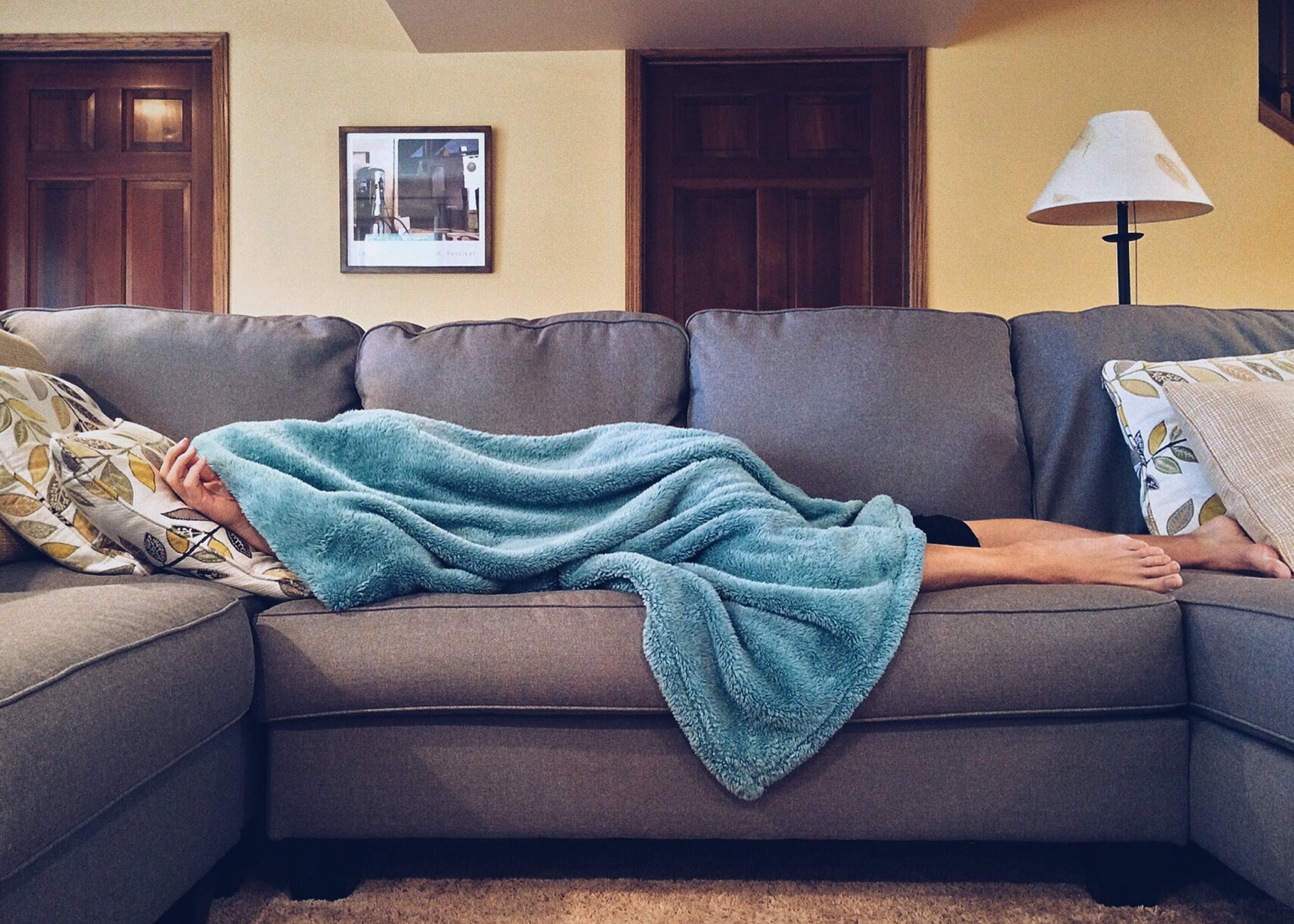
What’s Sleep Hygiene? (Plus, A Guided Meditation to Help You Relax)
Sleep is one of the most basic needs of humans, and getting quality sleep is essential for your mental and physical well-being. But how often do you get less-than-stellar sleep? When you’re running a busy house, it’s tempting to skimp on your sleep so you can conquer your to-do list, but sleep is a big priority for adults and children alike. If you wake up and are already counting down the seconds until bedtime, that’s a clear sign your body is screaming for more Zzz’s.
So how do you get the quality and quantity of sleep that your body deserves? By practicing sleep hygiene!
The Link Between Sleep and ADHD
The link between sleep and ADHD goes both directions. ADHD affects your ability to get quality sleep and a lack of quality sleep can exacerbate your ADHD symptoms.
The majority of people living with ADHD tend to have at least one of the following sleep-related problems:
- Difficulty falling asleep
- Feeling more alert and energized after dark
- Going to bed very late
- Difficulty relaxing (especially if you were hyperfocused on a task before bed)
- Difficulty awakening (regardless of how much you actually slept)
- Sleeping too much and still feeling tired
The above difficulties can impact ADHD in many ways. Not only do you feel tired (hello, brain fog!), sleep deprivation can diminish the effectiveness of ADHD medications! In addition a lack of sleep affects your physical and mental well-being. Lack of sleep:
- Weakens the immune system
- Diminishes working memory
- Makes it harder to concentrate
- Decreases creative problem solving
- Accelerates aging
- Affects academic and work functioning
- Lowers metabolism, increases appetite, and may even contribute to weight gain
- Increases irritability
ADHD symptoms — including hyperactivity, impulsivity, inattentiveness — may be exacerbated without enough sleep.
What Is Sleep Hygiene?
Sleep hygiene refers to both behavioral and environmental practices that promote good sleep. The term was originally coined in the 1970’s by experts treating insomnia, but the reality is that good sleep hygiene is essential for everyone. Good sleep hygiene helps you get the sleep you need.
16 Strategies to Combat Sleep Deprivation
- UNPLUG. Avoid TV and any technology 1 hour before bed
- Schedule relaxation time before bed
- Dim lights 1 hour before bed (and avoid all “blue lights” during this time as well)
- Try relaxation exercises or deep breathing
- Take a warm bath before bed
- Adjust your thermostat — cooler rooms enhance sleep quality so aim for 60-67 degrees Fahrenheit
- Keep your room as dark as possible during sleep
- Use a white noise/sound machine or an app for sleep sounds
- Gradually increase the amount of time you sleep, in 15 minute increments
- Start your bedtime routine earlier
- Keep a book by your nightstand
- Establish a consistent sleep schedule and try to head to bed at the same time every night
- Take a moment to imagine exactly what tomorrow will be like if you stay up too late
- Eliminate daytime naps
- Avoid caffeine at least 4 hours before bedtime
- Exercise helps you sleep better but avoid working out immediately before bed
These tips work well for children too. You can read more about children’s bedtime routines here.
Meditation and Relaxation
Have you ever laid awake at night with your thoughts racing? You’re not alone! It is nearly impossible to fall asleep with your mind racing.
A quiet mind can do wonders for sleep.
When it comes to practicing meditations or mindfulness, start small; consider a 1-minute meditation or mindfulness practice. You can also practice relaxation breathing:
- Take a deep breath in through your nose.
- Slowly exhale through your mouth.
- Practice throughout the day to create calm, and even in bed.
Try Progressive Muscle Relaxation:
How Can We Help You?
Take your self-care strategies to the next level with coaching. At NextStep 4 ADHD, we’re happy to provide 1:1 coaching for ADHD. If you’re struggling to eat a well-balanced diet or find the motivation to exercise, we offer online ADHD coaching via Zoom. Call 502-907-5908 or send us a message to request more information.
Don’t forget to sign up for our free newsletter so you can stay up-to-date with the latest news, free ADHD resources, and gain access to special events and more!
Learn More
Social Distancing & Exercise: The New Normal
Most of us feel like our worlds have changed. We’re working from home — if we even still have a job. Our kids are out of school and home with us all day long. They miss their friends, and we’re missing ours as well. We don’t leave home except for the most essential outings to the grocery store or doctor’s office. A trip to the gym is definitely out of the question. Our daily routines have been turned upside down, no doubt. These are challenging times for everyone, but the ADHD mind may struggle even more to cope with social isolation, boredom, and anxiety.
How do we stay sane, let alone healthy?
What if I told you there was a magical potion that could boost your immune system, calm your mind, strengthen your heart, improve your sleep, increase your energy, put you in a better mood, and even entertain your kids? Well, there is – and it’s the magic of PHYSICAL ACTIVITY! Before you groan and continue scrolling, consider this: Exercise does not need to be a drudgery. You can work it into the busiest of days, and you can make it fun!
And couldn’t we all use a little fun right now?
Fitting Fitness into Your Life
Here are 16 great strategies for incorporating movement into your life:
Move It!
- Incorporate short bursts of exercise. Even 5 minutes here and there can increase your energy level, improve concentration, and brighten your mood.
- Stretch daily. Gently stretching on a regular basis helps to ease tension, improve bodily comfort, and enhance relaxation and general wellbeing.
- Move regularly. When sitting for long periods, set an alarm to remind yourself to move. Get up and walk, climb stairs, stretch, etc. for at least 1 minute once an hour.
Take Advantage of Technology
- Invest in an activity or step–tracker. Establish your current steps per day, and gradually increase your daily step goal every 2 – 3 weeks.
- Search for workouts on YouTube. There is a wealth of exercise videos for beginners and experts alike readily available online. Many fitness centers are posting daily workouts so viewers can follow along at home. The above video is a great example of an at-home workout, without the need for any special equipment.
- Try a micro-workout. When you watch TV, get in the habit of using commercials for micro-workouts. This can include push-ups, planks, lunges, or even just a simple wall-sit.
- Dance. Turn the music up loud and dance!
- Use your equipment. Utilize home exercise equipment, but be sure to sanitize shared surfaces regularly.
Go Virtual
- Schedule Zoom, Skype, or other video exercise sessions with a friend or group of friends.
- Connect with loved ones on apps such as MyFitnessPal.
Tune Into Nature
- Get outdoors! Nature can be very calming and restorative. When possible, exercise outside. Practice social distancing, of course, and avoid touching surfaces that can harbor germs.
- Meet a friend or two for a walk outside. Stay on opposite sides of the street, to ensure healthy distancing. Having to shout to communicate will increase the cardiovascular challenge!
- Try something new. Other outdoor activities include running, hiking, cycling, outdoor yoga or Pilates, walking your dog, jumping rope, solitary Tai Chi, etc. Use your imagination to find ways to be active outdoors.
Involve Your Kids
- Get active with your kids. If you have children, create opportunities to be active together. Take them outside for a walk or a bike ride. Join them in a game of chase, baseball, soccer, etc. Make notes of your endurance level, and track your progress over the coming weeks. Not only will you enjoy quality time with your kids, but you’ll also be modeling the value of physical activity.
- Play active video games. Some video games, especially the fitness-based games, can be an entertaining way to exercise at home, both with your kids and by yourself. Remember to make it fun!
Schedule It
- Make it happen. Don’t wait for that sometimes elusive moment of inspiration. Schedule time for exercise on your calendar or in your planner today. Motivation often arrives later and even increases after you start an exercise program.
Above all, remember that a little bit of exercise is so much more than none. When you make time for physical activity, you are not only getting exercise – you’re creating a valuable habit that promotes your physical and mental health. Every time you exercise, you reinforce the habit of prioritizing movement.
To your health!
Want More Ways to Build Self-Care Strategies? Join Our Free Webinar
Don’t risk falling back into bad habits because you are stuck home! Join me online Tuesdays at noon to discover new, easy ways to stay on track with your nutrition, exercise, sleep, and stress. My experience includes a history of health coaching and more recently applying this expertise to help those who suffer from ADHD symptoms.
As a bonus, all registrants will also receive a free copy of our cookbook, On the ADHD Menu.
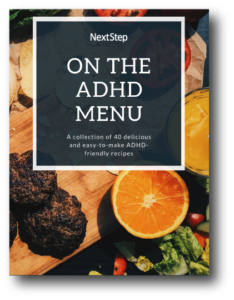
Take Self-Care to the Next Level with Virtual Coaching Sessions
At NextStep 4 ADHD, we’re happy to provide 1:1 coaching for ADHD. If you’re struggling to eat a well-balanced diet or find the motivation to exercise, we offer online ADHD coaching via Zoom. Call 502-907-5908 or send us a message to request more information.
Don’t forget to sign up for a membership so you can stay up-to-date with the latest news and gain access to special events and more!
Learn More

ADHD Diet: What We Eat & Why It Matters If You Have ADHD
We all know that it’s important to eat healthy foods, but did you know that good nutrition can make a huge difference in the management of ADHD symptoms? A poor diet can make anyone feel sluggish, distracted, and even depressed. [1] Add ADHD to the mix, and it is easy to see how a low-nutrition diet can intensify the daily challenges of living with ADHD. Many people find that incorporating nutrition-rich foods into their lifestyle greatly improves troublesome symptoms of ADHD.
That’s why the ADHD coaches at NextStep 4 ADHD are happy to help you navigate the challenges of establishing a nutrient-dense ADHD-friendly diet. From creating time-saving meal prep strategies to eliminating unhealthy food choices, our coaches are with you every step of the way.
In the meantime, continue reading to learn more about nutrition and how it affects those living with ADHD.
Why Good Nutrition Matters
You are what you eat. You’ve heard the saying, but have you ever really thought about it? What you eat can energize, provide essential nutrients, and power all of the major functions of your body.
What you eat and the quality of what you eat has a profound effect on your body. This is why runners often eat a carb-heavy meal before a run; because they know carbohydrates provide energy for the body. The opposite is also true. Poor nutrition impacts the body, too. For example, studies show that diets high in sugar tend to increase cravings and feelings of hunger. [2]
Here are a few benefits of a well-balanced, nutrient dense diet. Good nutrition:
- Can improve brain function
- Can increase energy levels and motivation
- Promotes general good health
- Can enhance your mood
- Can help you maintain a healthy weight
- Can help control symptoms of ADHD [3]
- Can improve sleep habits
- Balances blood sugar levels, which affect all of the above
The takeaway: good nutrition is important for a healthy mind and body, and in the next section, we’ll explore how ADHD can impact your food habits.
How ADHD Can Impact Food Habits
If you struggle with impulsivity or time blindness, you might be tempted to grab a fast meal, and unfortunately, “fast” isn’t always healthy. This isn’t the only way that ADHD can impact food habits. Below is a list of common ADHD symptoms and how those untreated symptoms can impact food habits.
Forgetfulness
Forgetfulness is a common ADHD symptom, and it can increase the likelihood that you forget to go shopping for food or even forget to eat. When you realize how hungry you are, you may then make desperate, unhealthy food choices.
Impulsiveness
If you’re feeling hungry, you might reach for whatever looks appealing in the moment.
Emotional regulation and stress tolerance
If you’re feeling stressed or overwhelmed, you’re more likely to engage in emotional or binge eating. According to the American Psychological Assocation, 38% of adults report stress eating as a way to cope with high stress levels.
Lack of Planning/Prioritization
Planning can be difficult for those with ADHD, and difficulty planning can affect what you eat as well. This may create challenges with:
- Planning shopping trips
- Meal planning
- Setting aside time to prepare healthy meals
In addition, difficulty planning can make it hard to come up with a realistic plan to improve eating habits.
Procrastination
The notion of procrastination is nothing new. It’s been discussed in literature dating back to Ancient Greece! [4] However, procrastinating can make it easy to put off the goal of improved nutrition.
Reduced Appetite
Stimulant medication may reduce your appetite. [5] While a reduced appetite can help prevent overeating (simply because you’re less hungry), a reduced appetite can work against optimal nutrition. If a reduced appetite results in skipping meals, it can make it challenging to consume adequate daily nutrients.
A Balanced ADHD Diet
A balanced ADHD diet looks a lot like a diabetes-friendly diet. Why? Because controlling blood sugar levels is beneficial in countless ways.
Have you ever waited too long between meals and gotten a headache, felt shaky, had brain fog, or become irritable? That’s an indication that your blood sugar levels have dropped to the point of causing physical symptoms. Time to listen to your body and eat! Better yet, plan ahead to avoid blood sugar crashes. By the time you experience symptoms, your body is going to crave simple carbohydrates to quickly raise your blood sugar levels. You likely won’t be reaching for broccoli at this point.
Maintaining healthy blood sugar levels helps to stabilize many symptoms of ADHD and can increase the likelihood of sticking with a high-nutrition diet.
A healthy diet is as much about what you eat as what you don’t eat. A balanced ADHD diet should include:
- Protein with every meal
- Vegetables and/or fruit with every meal
- Healthy fats like omega 3 fatty acids
- Fiber
It’s important to avoid:
- Processed foods
- High-sugar foods
- Artificial sweeteners
- Artificial dyes & preservatives
In addition to avoiding unhealthy additivies, avoid an attitude of deprivation – focus on incorporating healthy foods you love!
It may seem like a big task to overall your diet, but it can be done. Like all endeavors, remember that all journeys start with just one step.
But How Can You Improve Your Diet?
Keep these tips in mind:
- Start small. Consider focusing on one meal of the day. Maybe you want to start eating a healthy breakfast, packing a lunch for work, or learning some healthy recipes for dinner. Whatever it is, decide how many days per week you could do this, and make a plan.
- Before you start, go shopping. All the good intentions in the world can’t override a hungry stomach and nothing to eat but junk food. Make sure that you always have healthy food choices on hand, both at home and at work.
- Consider finding a friend or coworker (or coach!) who will start on a healthy eating plan with you. This adds in a layer of accountability and encouragement.
- Don’t stress over perceived failures. Establishing new habits takes time. It’s normal to fall back to old, easy eating patterns on your road to healthier eating. Just press restart on your healthier choices that same day. Keep at it, and your “fall-backs” will happen less often.
- Make it fun! Find ways to encourage yourself. Research recipes, try new foods, talk with a “foodie” friend who can give you some tips. Make your mealtime aesthetically pleasing – put on some music, clear the table of clutter, sit down and truly enjoy your food.
- Celebrate every small victory. Acknowledge your efforts as well as your successes. This not only feels good and encouraging, but it actually increases the chances of repeating the positive behavior. If you want to succeed with your healthy eating plan, be willing to treat yourself like a good friend.
Ready to Give Your Diet a Makeover? We’re Just a Call or Click Away
At NextStep 4 ADHD, we’re happy to provide 1:1 coaching for ADHD — and you don’t have to make the trip into our office. If you’re struggling to eat a well-balanced diet, we offer online ADHD coaching via telecoaching, coaching over the phone, or in-person coaching in our convenient Kentucky offices in Louisville and Lexington. Call the location of your choice, or send us a message to request more information.
Don’t forget to sign up for a membership so you can stay up-to-date with the latest news!
References:
- Pelsser, Lidy M., Klaas Frankena, Jan Toorman, Huub F. Savelkoul, Anthony E. Dubois, Rob Rodrigues Pereira, Ton A. Haagen, Nanda N. Rommelse, and Jan K. Buitelaar. “Effects of a Restricted Elimination Diet on the Behaviour of Children with Attention-deficit Hyperactivity Disorder (INCA Study): A Randomised Controlled Trial.” The Lancet, vol. 377, no. 9764, 2011, pp. 494-503.
- Penaforte, Fernanda Ro, et al. “Short-Term Impact of Sugar Consumption on Hunger and Ad Libitum Food Intake in Young Women.” Nutrition Research and Practice, The Korean Nutrition Society and the Korean Society of Community Nutrition, Apr. 2013.
- Pelsser, Lidy M. J., et al. “A Randomised Controlled Trial Into the Effects of Food on ADHD.” European Child & Adolescent Psychiatry, vol. 18, no. 1, 2008, pp. 12–19., doi:10.1007/s00787-008-0695-7.
- https://www.psychologicalscience.org/observer/why-wait-the-science-behind-procrastination
- Jeffers, Amy J, and Eric G Benotsch. “Non-Medical Use of Prescription Stimulants for Weight Loss, Disordered Eating, and Body Image.” Eating Behaviors, U.S. National Library of Medicine, Aug. 2014, www.ncbi.nlm.nih.gov/pubmed/25064292.
